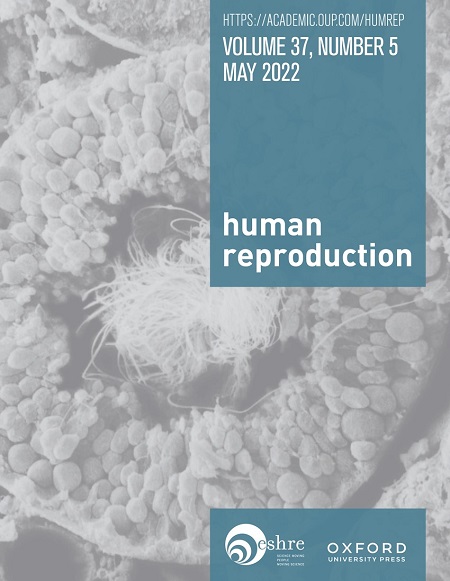Patterns of health service use before and after diagnosis of endometriosis: a data linkage prospective cohort study
IF 6
1区 医学
Q1 OBSTETRICS & GYNECOLOGY
引用次数: 0
Abstract
STUDY QUESTION What are the patterns of health service use (HSU) before and after endometriosis diagnosis? SUMMARY ANSWER Women with endometriosis had higher rates of visits to general practitioners (GPs), specialists, and diagnostic imaging before and after diagnosis compared to those without the condition; however, after diagnosis, their visits to GPs and specialists other than obstetricians/gynaecologists decreased compared to before, while visits to obstetricians/gynaecologists and use of diagnostic imaging increased. WHAT IS KNOWN ALREADY Women with endometriosis have higher rates of healthcare use compared to those without the condition; however, no longitudinal study has examined patterns of HSU over a prolonged period before and after diagnosis. STUDY DESIGN, SIZE, DURATION The Australian Longitudinal Study on Women’s Health linked to a national administrative health record. A total of 30 473 women, born in 1973–1978 and 1989–1995, from two cohorts with data collected from 1996 to 2021, as online or postal questionnaires. PARTICIPANTS/MATERIALS, SETTING, METHODS Women with endometriosis were identified using the self-report surveys and their administrative health records. A control group of women without endometriosis was randomly selected and age-matched with women with endometriosis. The final sample included 9545 women from the 1973–1978 cohort (1909 cases, 7636 controls) and 7510 from the 1989–1995 cohort (1502 cases, 6008 controls). Women’s HSU was assessed using the Medicare Benefits Schedule database. A random intercept zero-inflated negative binomial model was used to compare outcomes between cases and controls, addressing skewed data, over-dispersion, and excess zeros. MAIN RESULTS AND THE ROLE OF CHANCE In both cohorts, women with endometriosis had a higher level of HSU, both before and after diagnosis, compared with those without the condition. For the 1973–1978 cohort, women with endometriosis had a higher rate of visits to GPs before and after diagnosis (adjusted incidence rate ratio: 1.19, 95% CI 1.14, 1.23 and 1.24, 95% CI 1.19, 1.30, respectively), specialists other than obstetricians/gynaecologists (1.50, 95% CI 1.40, 1.61, and 1.36, 95% CI 1.27, 1.46), and for diagnostic imaging (1.15, 95% CI 1.10, 1.21, and 1.20, 95% CI 1.15, 1.26). The average number of these visits remained consistent in the early years, peaked around 3 years before diagnosis, and then partly declined post-diagnosis, to later stabilize at a higher level than those without the condition. Following the diagnosis, women with endometriosis had a higher number of visits to obstetricians/gynaecologists (1.11, 95% CI 1.05, 1.17) than their matched controls, with a marked increase in the first 6 years post-diagnosis, but gradually returned to same levels as the control group. After diagnosis, women with endometriosis had a lower rate of visits to GPs (0.95, 95% CI 0.93, 0.98) and specialists other than obstetricians/gynaecologists (0.88, 95% CI 0.82, 0.93) compared to before their diagnosis, while they had a higher rate of visits to obstetricians/gynaecologists (1.09, 95% CI 1.01, 1.18) and diagnostic imaging (1.07, 95% CI 1.01, 1.14). Similar patterns of HSU were observed in the 1989–1995 cohort, regardless of whether surgically confirmed or clinically suspected cases of endometriosis were used, though the evidence for changes in specific HSU before and after diagnosis was weaker. LIMITATIONS, REASONS FOR CAUTION Approximately half of the women with endometriosis were clinically suspected cases without laparoscopic confirmation, which may result in an overestimation of prevalence and introduce the risk of misdiagnosis, potentially influencing clinical management and research findings. WIDER IMPLICATIONS OF THE FINDINGS The continued high level of HSU among women with endometriosis, even over a decade after diagnosis, suggests that they have substantially greater healthcare needs than other women. The distinct patterns of the use of healthcare in the years before and after endometriosis diagnosis can support efforts to improve diagnosis, management, and treatment outcomes for patients and to reduce healthcare costs. STUDY FUNDING/COMPETING INTEREST(S) The Australian Longitudinal Study on Women’s Health is funded by the Australian Government Department of Health and Aged Care. G.D.M. and G.M. are Australian National Health and Medical Research Council Leadership Fellows (GNT2009577 and GNT1177194). D.G.G. was funded by MRFF EndoAIMM (RFEHP100126). Funding sources had no role in the study design, data analysis, interpretation, or manuscript writing. The authors have no conflict of interest to declare. TRIAL REGISTRATION NUMBER N/A.子宫内膜异位症诊断前后的卫生服务使用模式:一项数据链接前瞻性队列研究
研究问题子宫内膜异位症诊断前后的卫生服务使用(HSU)模式是什么?与没有子宫内膜异位症的女性相比,患有子宫内膜异位症的女性在诊断前后就诊全科医生(gp)、专科医生和诊断成像的比例更高;然而,在诊断后,他们去看全科医生和产科/妇科医生以外的专家的次数比以前减少了,而去看产科/妇科医生和使用诊断成像的次数增加了。与没有子宫内膜异位症的女性相比,患有子宫内膜异位症的女性有更高的医疗保健使用率;然而,没有纵向研究在诊断前后的长时间内检查HSU的模式。研究设计、规模、持续时间澳大利亚妇女健康纵向研究与国家行政健康记录相关。共有30473名女性,出生于1973-1978年和1989-1995年,来自两个队列,数据收集于1996年至2021年,通过在线或邮寄问卷调查。参与者/材料、环境、方法使用自我报告调查和她们的行政健康记录确定子宫内膜异位症妇女。随机选择无子宫内膜异位症的妇女作为对照组,与子宫内膜异位症妇女年龄匹配。最终样本包括1973-1978年队列的9545名女性(1909例,7636例对照)和1989-1995年队列的7510名女性(1502例,6008例对照)。使用医疗保险福利计划数据库评估妇女的HSU。使用随机截距零膨胀负二项模型来比较病例和对照组之间的结果,解决数据偏斜、过度分散和过量零的问题。在这两个队列中,患有子宫内膜异位症的女性在诊断前后的HSU水平都高于没有子宫内膜异位症的女性。在1973-1978年的队列中,患有子宫内膜异位症的妇女在诊断前后就诊全科医生(调整后的发病率比分别为1.19,95% CI 1.14, 1.23和1.24,95% CI 1.19, 1.30)、产科医生/妇科医生以外的专科医生(1.50,95% CI 1.40, 1.61和1.36,95% CI 1.27, 1.46)和诊断成像(1.15,95% CI 1.10, 1.21和1.20,95% CI 1.15, 1.26)的比例更高。这些就诊的平均次数在早期保持一致,在诊断前3年左右达到高峰,然后在诊断后部分下降,后来稳定在比没有这种情况的人更高的水平。诊断后,患有子宫内膜异位症的妇女就诊产科医生/妇科医生的次数比对照组高(1.11,95% CI 1.05, 1.17),在诊断后的前6年显著增加,但逐渐恢复到与对照组相同的水平。诊断后,与诊断前相比,子宫内膜异位症患者就诊全科医生(0.95,95% CI 0.93, 0.98)和产科医生/妇科医生以外的其他专家(0.88,95% CI 0.82, 0.93)的比例较低,而她们就诊产科医生/妇科医生(1.09,95% CI 1.01, 1.18)和诊断成像(1.07,95% CI 1.01, 1.14)的比例较高。在1989-1995年的队列中,无论使用手术确诊还是临床怀疑的子宫内膜异位症病例,都观察到类似的HSU模式,尽管诊断前后特异性HSU变化的证据较弱。局限性、谨慎的原因:大约一半的子宫内膜异位症患者是未经腹腔镜确认的临床疑似病例,这可能导致对患病率的高估,并引入误诊的风险,潜在地影响临床管理和研究结果。研究结果的更广泛含义子宫内膜异位症女性中持续高水平的HSU,甚至在诊断后超过十年,表明她们比其他女性有更大的医疗保健需求。子宫内膜异位症诊断前后的不同医疗模式可以帮助改善患者的诊断、管理和治疗结果,并降低医疗成本。研究经费/竞争利益(S)澳大利亚妇女健康纵向研究由澳大利亚政府卫生和老年护理部资助。G.D.M.和G.M.是澳大利亚国家卫生和医学研究委员会领导研究员(GNT2009577和GNT1177194)。D.G.G.由MRFF endoaim (RFEHP100126)资助。资金来源在研究设计、数据分析、解释或手稿写作中没有作用。作者无利益冲突需要声明。试验注册号n / a。
本文章由计算机程序翻译,如有差异,请以英文原文为准。
求助全文
约1分钟内获得全文
求助全文
来源期刊

Human reproduction
医学-妇产科学
CiteScore
10.90
自引率
6.60%
发文量
1369
审稿时长
1 months
期刊介绍:
Human Reproduction features full-length, peer-reviewed papers reporting original research, concise clinical case reports, as well as opinions and debates on topical issues.
Papers published cover the clinical science and medical aspects of reproductive physiology, pathology and endocrinology; including andrology, gonad function, gametogenesis, fertilization, embryo development, implantation, early pregnancy, genetics, genetic diagnosis, oncology, infectious disease, surgery, contraception, infertility treatment, psychology, ethics and social issues.
 求助内容:
求助内容: 应助结果提醒方式:
应助结果提醒方式:


